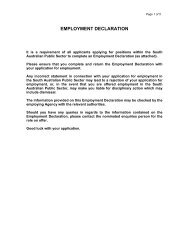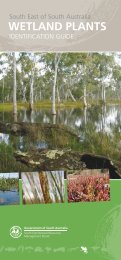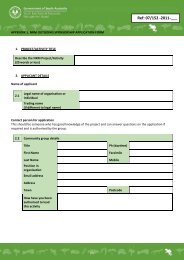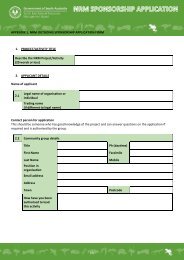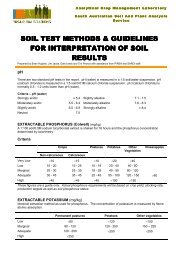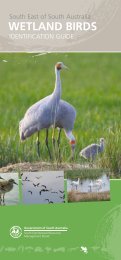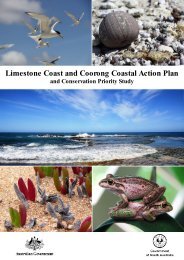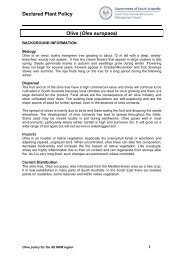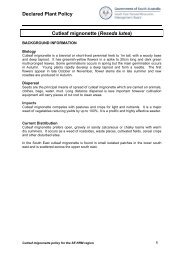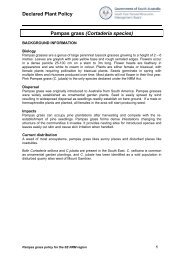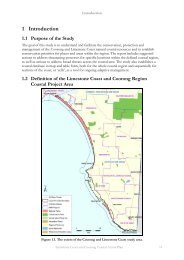Cell Descriptions - South East Natural Resources Management Board
Cell Descriptions - South East Natural Resources Management Board
Cell Descriptions - South East Natural Resources Management Board
You also want an ePaper? Increase the reach of your titles
YUMPU automatically turns print PDFs into web optimized ePapers that Google loves.
SE6 – Lake Bonney SE<br />
NOTE: the advice below is indicative of likely change and the direction of change, with<br />
implications for ecosystems. Dates, amounts and probabilities cannot be accurately calculated at<br />
this time. Thus advice on flood levels, for example, should not be used in engineering or<br />
development planning.<br />
Climate change<br />
element/ scenario<br />
Combined<br />
climate changes<br />
and sea level rise<br />
throughout this<br />
cell<br />
Sea level rise:<br />
2030 : +c.20cm<br />
2070: +c.80cm.<br />
Storms:<br />
Frequency continues<br />
to show great<br />
variation on a<br />
decadal scale.<br />
Intensity of large<br />
storms increases.<br />
Warmer average<br />
conditions:<br />
2030:+0.3 to.6 0 C<br />
2070:+1.5 to 2 0 C<br />
Drier average<br />
conditions:<br />
2030: -2% to 5%<br />
2070: - 10% to 20%<br />
‘Flashy’ run off:<br />
Drier creeks, but<br />
larger rare floods<br />
Groundwater<br />
lowering; saline<br />
incursion:<br />
Impacts and implications Protect and manage Address landscape<br />
(for this cell) habitat threats issues: fire,<br />
connectivity,<br />
refuges, hydrology<br />
This cell presents a<br />
complex pattern of habitats<br />
sensitive to change.<br />
Increase in storm foredune<br />
damage and beach<br />
recession. The partially<br />
buried calcarenite<br />
topography could well lead<br />
to an indented coastline, of<br />
reefs and embayments.<br />
Foredune damage leads to<br />
dune de-stabilisation, and<br />
transport of sand across the<br />
barrier.<br />
2030: Occasional storm tide<br />
flooding above highest<br />
known tides.<br />
2070: Flooding will affect<br />
all swamps and adjacent<br />
low lying areas.<br />
Frequent storm damage to<br />
foredunes.<br />
(Impacts uncertain.<br />
Existing terrestrial<br />
vegetation is found in<br />
warmer conditions<br />
elsewhere)<br />
Dune vegetation adapts<br />
well to drier conditions, but<br />
recovers more slowly from<br />
fire, disease and storm<br />
damage: dune mobilization<br />
becomes more likely.<br />
Drains and creeks may<br />
increase sediment load to<br />
coastal swamps and lakes<br />
(this depends on land<br />
management practices).<br />
Aridity and sea level rise a<br />
threat to perched<br />
freshwater table within the<br />
Create a baseline for<br />
shoreline, dune and lake<br />
change by establishing a<br />
rectified aerial<br />
photographic record at an<br />
appropriate resolution.<br />
Maintain an aerial<br />
photographic record of<br />
shoreline change.<br />
Active management of<br />
dune blowouts.<br />
Manage sill height on tidal<br />
inlet to adjust to higher<br />
marine storm elevations<br />
as part of the adaptive<br />
management of Lake<br />
Bonney.<br />
Active management of<br />
dune blowouts.<br />
Active weed control<br />
within dunes.<br />
Maintain watching brief<br />
on sedimentation of Lake<br />
Bonney.<br />
Monitor salinity in small<br />
freshwater lakes. Adaptive<br />
management of plant<br />
Maintain<br />
connectivity of<br />
vegetation within<br />
the region.<br />
Limestone Coast and Coorong Coastal Action Plan 299



